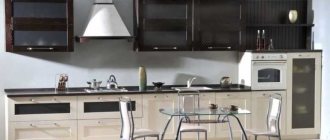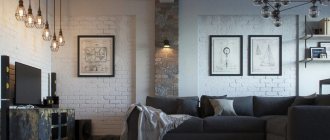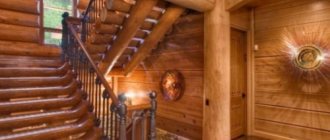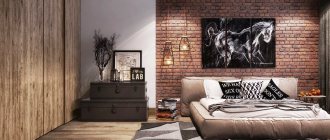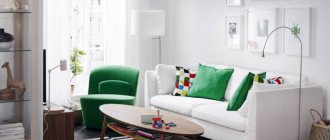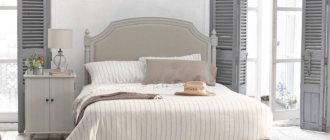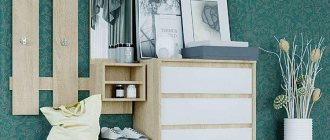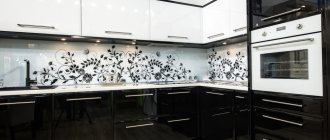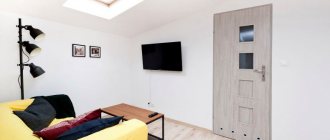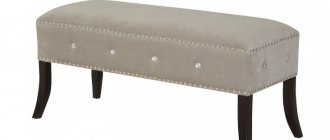History of the emergence of Art Nouveau
The emergence of this style was provoked by that incredibly chaotic eclecticism, which at the end of the 19th century became the most commonly used in the design of European interiors. All styles known at that time were mixed, shuffled, piled on top of each other, but did not give a new result. The rooms remained the same recognizable, long tired of, did not differ in any originality or classical purpose, they were just a repetition of previous designs, often in a not very successful combination.
The emergence of a new style was a natural process, accelerated by the rapid development of new technologies that required their implementation. At first, Art Nouveau design was perceived as a sign of bad taste and appeared in few houses. Mostly, it was resorted to by extraordinary individuals who wanted to stand out from the crowd in this way.
Modernism did not last long at the peak of popularity. Its decline began in the second decade of the twentieth century. This was due to the high cost of manufacturing furniture and finishing materials necessary for the purity of the style. The development of industry, which put the production of objects on the assembly line, finally shook the foundations of the style, and the First World War put an end to its popularization.
Modern in different countries
The new progressive and very bold style quickly spread throughout the world, finding millions of fans. In each country it has its own name:
| In America it is Tiffany. Named in honor of the famous artist and designer L. K. Tiffany, the author of the original glass connection in stained glass production. |
| For the French, this is Art Nouveau, which means “new art”. |
| “Young art” or art nouveau among the Germans. |
| Modern style from the British. |
| Secession among the Austrians. |
| Liberty for Italians. |
| Modernism among the Spaniards. |
| Spruce style in Switzerland. |
Each culture left its mark on the development of style, and soon two main directions appeared: decorative and constructive. The first was typical for Scotland and Austria. The second was followed by Germany, Belgium, and France. The Russian style can be identified as a separate group, the development of which was strongly influenced by folk traditions. But this division is very conditional. It is not for nothing that designers consider modernism the most complex of all known styles - it has absorbed such a huge number of trends, been influenced by so many cultures that it is sometimes very difficult to determine the line between it and eclecticism or art deco.
Russian modern
In Moscow, not far from the Cathedral of Christ the Savior, there is a famous house in the Russian Art Nouveau style.
After the revolution there were communal apartments there. Not so long ago, the building was completely restored using archival documents and drawings... Marina Dyachkova is an “artist-constructor, designer of interiors and household items.” This is exactly what the name of her profession sounded like in Soviet times. After graduating from the institute and working in her specialty for two years, by the will of fate she ended up in the Moscow Patriarchate and became interested in ancient Russian painting. She painted icons on lecterns, large icons, frescoes and was involved in restoration. “Ancient Russian painting puts a person in a certain mood, cultivates his taste and makes the artist not only a good graphic artist, but also a colorist. Therefore, colors in the interior play a very important role for me,” says Marina Dyachkova.
SALON:
When you came to this apartment, was it already finished?
— Yes, my customers bought it after restoration with finishing. Although we reconstructed the parquet again, we restored the marble. Since I know the customer and his lifestyle well, I immediately had a scenario for how to plan this space. From the large beautiful hall we enter the living room, which I divided into three parts - a relaxation area by the fireplace, a soft area and a dining room. In the private part there are two bedrooms, an office, a small bathroom with a shower and a large bathroom. The kitchen is located separately, as was customary at the beginning of the last century.
S:
What is left of that old modernism in this apartment and house?
- Everything. Moreover, it is genuine modernity, not a remake. The facade of the building itself, the halls, and even the door handles in the entrance were preserved and restored. The apartment also preserves original decorative friezes in the hallway (we call them crackers), ceiling moldings, graphic windows and fireplace chimneys. As a decorator, I decided to make carpets in the Art Nouveau style. Nobody has ever made carpets in this style. They simply don't exist. For example, in the living room there is a carpet, the sketch of which I copied from a Faberge enamel brooch. The silhouette of the carpet itself is smooth, viscous and resembles a huge blurry drop. The curtains and carpet in one of the bedrooms are based on Faberge paintings.
S:
Art Nouveau is back in fashion... What is the difference between true Art Nouveau and what we sometimes mistake for this style?
— If you are making an interior in this style, then the main thing is not to overdo it. After all, modernism is a style, as I call it, curly, and there are no laws of right angles. But it is not as heavy as is now commonly believed. One of the symbols of Art Nouveau is the delicate iris flower. When the interior is oversaturated with plant and natural elements, the space becomes heavy; in such apartments and houses the interior “presses”. I re-drew all the stained glass windows in this apartment. I took the theme of the twig. And I used this branch in the decor of the entire apartment. In the office, for example, it appears on oak shelving, on the fireplace portal, and in the hall - on stained glass windows.
S:
You said that colors and shades in the interior are very important to you. Therefore, you were engaged in the selection of not only furniture, lighting, textiles, but also accessories?
— There are no small details in the interior.
I ordered the furniture from a small Italian factory, and it was all handmade; I covered some of the lamps myself with antique gold. I looked for things from that time in antique shops and junkyards. Some had to be restored. For example, a porcelain fruit bowl depicting two dancing bacchantes is an early 20th-century piece. First of all, I was surprised by the color of the tunics - one was olive, the other with shimmering terracotta. The organza tablecloth on the dining table is gold with a lilac hue. All these colors exactly matched the colors of the interior - olive, pistachio, lemon, lilac, old gold and terracotta. They can be seen in the folds of fabric, they appear on sofas and carpets, in accessories and fabric wallpaper. Everything in this interior is alive - either individual work, or unique quotes from that time, or genuine items from the Russian Art Nouveau era. Author of the project Marina Dyachkova:
“When I first came to this apartment, I took off my hat to those people who restored it from scratch. The interior work fell on me, and I tried to preserve what happened as a result of the reconstruction. I just needed to pick up the style that was given and support the lack of pretentiousness and nobility in this interpretation of Russian Art Nouveau.”
Accessories for shooting were provided by the English Interiors salon and the Park Avenue showroom
page 1 of 3 Next page>>
Distinctive features of the Art Nouveau style
Each style has its own distinct differences, allowing even a barely knowledgeable person to accurately identify them.
Modernism in the interior is:
#1. An abundance of wooden elements. The interior in the Art Nouveau style does not accept non-natural materials. The most affordable and versatile is wood. It is used to create furniture, wall panels, decorative elements for walls, ceilings, flooring, windows and doors. The most commonly used wood is hardwood with a pronounced structure: beech, oak. When processing it, dull painting, which hides the structure of the fibers, is not allowed.
#2. Complete absence of straight lines. Smooth, soft contours, without any angles, often imitating plant elements.
#3. The shapes are smooth, devoid of any symmetry. Harmonious flow from one to another. Vertical dominant.
#4. Natural themes in decor: stylized plant and animal patterns. Initially, Art Nouveau gravitated towards a simplified image of lilies, petals and leaves, butterflies and dragonflies. But today these elements are not mandatory. You can select them according to your own taste.
#5. Stained glass used to decorate windows, doors, ceilings and lamps. The technique of their manufacture is not important - from expensive Tiffany to pseudo-stained glass created by painting. Only the theme of the drawing is important. It should be in tune with the general mood of the room. Most often this is a floral design using flexible stems, soft petals and smooth abstraction.
#6. Windows rising upward, often arched or huge, such as display windows, decorated with floral decorations. In the Art Nouveau style, windows are used not only for their intended purpose, but are also a full-fledged element of the decor of the room, complementing, and often putting an end to its design.
#7. Doors are rectangular or arched. Wide, preferably double-leaf. Flat, with elements of mosaic decor. A distinctive feature of Art Nouveau doors is the windows on the top and sides of the doorway, most often decorated with stained glass. This creates an additional feeling of open space.
#8. The stairs and steps are wide, always decorated with forged railings with openwork patterns.
Entrance door decorated with stained glass in Art Nouveau style.
Staircase in Art Nouveau style.
Classic negation style
The emergence of the Art Nouveau style was predetermined by the very history of the development of European civilization. The end of the 19th century was the heyday of the technical revolution and political and economic changes in almost all European countries. The “ghost of communism” is wandering across the continent, the ideas of the primacy of science over religion, the desire to reject the patriarchal and create a new technological society are taking root in the minds...
Initially, interiors in the Art Nouveau style, like everything new, were considered not even fashionable - it was bad taste mixed with perversion... however, the revolution in worldview, which then affected almost all people who considered themselves to be part of a civilized society, did its job - and the Art Nouveau style at least and not for long, but still became widespread.
The essence of the Art Nouveau style is the contrast with the classic interiors of that time. Straight, clear lines of furniture and space have not gone out of fashion for many centuries - Art Nouveau made the main ones in the interior the sinuous lines that hide the transition from one element of the furnishings to another. A characteristic feature of the style is the roundness of the rooms, smoothness (no clearly defined corners), “flexibility” and plasticity of the furniture.
Features of room layout in Art Nouveau style
Modernism tends to have a lot of free space, so a medium-sized or larger room is suitable for design in this style. It is best if it is a studio apartment. Its layout allows you to unobtrusively zone the space, using only floor coverings and ornate openwork partitions with necessarily wavy arcuate lines.
The dividing line on the floor should not have corners and be smooth. Zoning lines can be duplicated with partitions, furniture, carpets, large decorative elements and even floor patterns.
The second option, which best suits modern design, is an apartment with a non-standard layout. This arrangement is most suitable for creating an interior that gravitates towards non-standard and asymmetrical shapes. After all, with the help of Art Nouveau you can veil the unfortunate shape and arrangement of rooms.
Style color scheme
The naturalness of the material used to create a modern interior is emphasized by natural colors.
All of them should be muted, not flashy, in pastel colors:
Shades of brown.
Pearl.
Wet asphalt.
Beige.
Silver.
Black.
The purpose of color is to give the interior lightness and romance.
Suitable for contrast:
Red.
Yellow.
Fuchsia.
But there should be a small number of these accents.
It is important to choose the right balance of colors for decoration, furniture and textiles so that the room creates the impression of a single whole, and not a mixture of disparate elements. In modernity, which allows for all sorts of deviations and innovations, such a fragile line is very easy to miss. As a result, instead of a stylish interior, you get the same eclecticism, and often of very poor quality.
First of all, it is necessary to determine the accent element, and only then adjust the background and additional color fillings to it. If it is necessary to draw attention to luxurious furniture, the color of the walls, the richness of the stained glass windows or the pomp of the ceiling decoration should in no case interrupt it. Be proud of the designer stained glass windows on the windows, ceiling and doorway - furniture, walls and floors should be made in pastel colors of one or two colors in different tones. You should not use too many colors - after all, we are creating an interior that is comfortable for the eyes, and not a rainbow, even if all its colors are harmonious with each other.
In modernism, which gives preference to space and air, excluding additional partitions, you can use color to zone a room. The main thing is that all elements of each zone are consonant and in no case conflict with each other. You can experiment with the color scheme of each zone at your own discretion, remembering to adhere to the basic color requirements.
Art Nouveau walls
The walls create only a background, but in no case draw attention to themselves. Therefore, to paint them, light, non-flashy shades are used: pearl, cream, milky white, light gray. Texture is unacceptable. For some rooms where it is necessary to create a certain intimacy and intimacy, you can take darker tones of wine and brown.
They should be muted, without gloss. To avoid excessive gloom from a dark color, the walls can be decorated with discreet floral patterns. Its distinctive feature is its vertical arrangement, simulating the natural growth of plants.
Sometimes designers prefer to decorate the lower part of the walls with wood panels, which in some cases is more practical, for example in the hallway. The panels should be made of natural wood or, in extreme cases, a cheaper artificial material that imitates it. The upper part of the walls is covered with silk or paper wallpaper in pastel shades. In any case, the decorated walls should not attract attention, thereby drowning out the interior decoration of the room.
Ceiling decoration in Art Nouveau style
The ceiling in the Art Nouveau style should be given special attention. Unlike the walls, it is very richly decorated. This can be voluminous gypsum stucco or wooden elements. It is in the ceiling that the influence of the classics on the formation of this style is most felt. Its static elements fit very organically into the outlandish interweaving of wavy lines and look great in asymmetry, smoothly weaving through the rooms in a dynamic pattern.
Stained glass windows are often placed on the ceiling, which are an invariable and very important attribute of Art Nouveau. Illuminated with muted light that does not hurt the eyes, they create a special mood in the room. Moreover, a stained glass window made according to the owner’s own design is a great way to express yourself and make your personal contribution to the design of the room.
We understand the history of the origin of style and terminology
For a better perception of the direction under consideration, it is necessary to briefly become acquainted with its history, because the events that took place, like nothing else, influenced not only the process of emergence and development, but also the fact of the decline of the direction.
Historical reference
- The end of the 19th century was marked by a kind of crisis in all spheres of society, which could not but affect architecture, painting and design. This time was characterized by so-called historicism, which consisted of imitation of the past, mixing old styles and an awkward presentation of eclecticism.
- Progress also played a role. The technological leap and the transition from craft to mass production seemed to push us to learn and put into practice something new, unlike anything else.
- Art Nouveau was first used in graphics and painting and soon gained worldwide recognition in all spheres of art. The interiors of that time were of a demonstrative decorative and applied nature, expressed in imitation of natural motifs and forms. The main distinguishing feature is a curved, ornate line, reminiscent of a stem or even a curl.
- She could be depicted anywhere: in decor, decoration, on fabrics, and even the shapes of stair railings contained a characteristic element.
- The beginning of the end for the style can be marked as 1910. Such short-lived popularity can be explained quite simply: since the style was truly a striking and somewhat extraordinary phenomenon, it had both supporters and opponents. Moreover, the expensive furniture required to decorate modern interiors gradually gave way to cheap mass production of items accessible to the majority of the population.
- The final blow was dealt, of course, by the outbreak of the First World War, which finally overthrew the seemingly well-established positions of the “modern” style.
- It is being replaced by the luxurious and sophisticated Art Deco style, the history of which was also short-lived.
On a note! A follower of Art Nouveau, Art Deco, at the end of its development, had many features characteristic of its predecessor. This can be called a kind of fusion of trends, occurring under the influence of the evolution of style, technological progress and many other social phenomena. Art Deco and Art Nouveau interiors coexisted well, especially in America. Their decline is associated with the spread of internationalism.
Established style directions depending on geographical location
Modernism in interior design can be expressed in different ways. The thing is that the style is characterized by a certain fragmentation and partly even diversity.
This lies primarily in the lack of internationality. That is, the direction, having become world famous, never became international and manifested itself differently in each country.
- In France - in the form of art nouveau;
- The Scandinavian and German version is called Art Nouveau;
- American Art Nouveau was called Tiffany;
- Italian - liberty;
- Austrian - secession.
As for the origin of the names:
- Art Nouveau was named after the store that was first decorated in the Art Nouveau style;
- Jugendstil was referred to as a magazine around which adherents of the “Young Style” were grouped;
- Secession, or, more precisely, the very name of the movement, which means “departure” or “separation” in translation, is associated with the protest of cultural figures against academic art.
Style directions
That is, the spread of Art Nouveau occurred differently in individual territories. But, despite the different names, the historical interior in the Art Nouveau style has its own bright characteristic features, and they are contained in all design options, regardless of the country.
At the moment, there are still debates about all of the above trends in design. Most interior specialists and also historians argue that the names of the styles are synonymous. It is not possible to come to a single point of view, but the obvious similarity of trends, including temporary ones, cannot be ignored.
This version of development and spread resembles the path of country music: the direction in all countries is considered rural, it reflects life and culture, but at the same time different, in accordance with the unique history and geographical location.
Art Nouveau floor
Flooring is a very important component in the design of a room of any style. In modernity, gender is not an active component. It should fit harmoniously into the overall picture, not suppress or “disappear.” Setting off the decoration of the room, it can be darker than the walls or in the same tone.
The floor allowed by the rules of modern modernism in the interior is wooden parquet, laminate, natural tiles or stone. The parquet can be laid out in a classic herringbone pattern or in a specific design with the obligatory smooth lines of the pattern. Laminate should be in natural colors similar to a wooden board. Modern technologies make it possible to create a design laid out from natural stone or porcelain stoneware, carved in any shape.
Classic floor design in Art Nouveau style.
Useful tips
When arranging an interior in the modernist style, the following points should be taken into account:
- the main color is neutral, accessories are selected to match it or in contrasting shades, depending on the design idea;
- in the trend are paintings with abstraction, works by masters of surrealism, cubism, expressionism, paintings with powerful energy;
- it is important to adhere to the principles of minimalism when choosing accessories, plan their quantity in accordance with the dimensions of the room in order to avoid the risk of cluttering the space;
- large windows, panoramic systems, light openings from floor to ceiling are relevant;
- Solar panels are welcome to enhance the energy efficiency of the home.
In interior design with an emphasis on functionality and constructive solutions, all kinds of sliding structures are in demand, including:
- wardrobes;
- folding tables and sofas, transformable structures;
- retractable models of cabinets, shelves, beds;
- sliding type interior doors.
This allows you to properly organize the space and, if necessary, quickly update the situation with a minimum of effort.
Selection of furniture
Furniture that is correctly selected in style is convenient, comfortable, with smooth outlines. It should beckon you to rest. Complete absence of any corners. Sofas and beds have maximum asymmetry in the backs. The backs of the chairs tend upward in strange waves. The proportions of cabinet furniture are as dominant as possible towards the vertical.
Modern is a very flexible style, so classic furniture with a bizarre shape will fit perfectly into it. Furniture in a minimalist style is also suitable for it, if it is complemented with appropriate decor, expressive patterns and stained glass details. The main rule in choosing furniture, from which you cannot deviate, is natural color and material.
The amount of furniture should be clearly designed taking into account the purpose of the room. An excess of objects is not allowed, creating clutter that is not acceptable for this minimalist style that requires a lot of air. Upholstered furniture is not a modern item, but in some rooms it is necessary. It should be as small as possible, only for the intended purpose.
In terms of color scheme, it should fit into the overall picture; wood should radically predominate over textiles. The textiles themselves are made in muted pastel colors. Among standard industrial upholstered furniture, you should select items with a minimum number of corners, rounded soft armrests, discreet textiles and floral patterns.
Furniture in Art Nouveau style.
Download the Interior Design 3D program
Arrange your apartment in Art Nouveau style and immediately evaluate the result in 3D
Interface language: Russian
Distribution size:88.5 MB
Content:
- 1. History of the Art Nouveau style
- 2. Features
- 3. Art Nouveau finishing options
- 4. Art Nouveau furniture
- 5. Art Nouveau decor options
- 6. What colors to use in the interior
- 7. Lighting
- 8. Renovation in Art Nouveau style
- 9. Kitchen (with photo)
- 10. Living room (with photo)
- 11. Bedroom (with photo)
- 12. Bathroom (with photo)
Lighting
For modernism, lighting fixtures, their appearance and location, are important. In this case, it is better to adhere to the classical rules. They will allow you to emphasize that the interior belongs to the style, even if there are minor flaws in the rest.
A ceiling lamp in the Art Nouveau style is a permanent chandelier with the obligatory crystal decorative elements, luxurious and eye-catching. All its metal elements are gold-plated or forged. For bedrooms and boudoirs, you can use a chandelier made in Tiffany stained glass style. Multi-colored glass, shimmering with fancy reflections from the turned on light, will become a bright accent spot in the room.
It is desirable that floor and table lamps have something in common with the chandelier in their design technique. The base and legs of floor lamps should be made of natural material, metal or wood, and not fall out of the overall color scheme of the interior.
Additional lighting in the form of wall lamps is possible. They are often used for zoning. Their base should be made of natural material, and the lampshades should be conical or round in shape.
All lighting fixtures have a complex shape, possibly with decorative elements in the form of intricate monograms, flowing plant elements, asymmetrical and elegant due to their ideal lines.
Modern chandelier in Art Nouveau style.
We decorate the premises
Modernism style in the interior can be applied in different ways. If you want to completely recreate the original, then this will be the most difficult task. It will require serious investment and time. For a decorative design, it is necessary to use the basic elements and reflect the characteristic features.
But with a superficial design, only the presence of a few accents characteristic of the style and the corresponding color scheme is enough.
The choice, of course, is up to you, and below we will try to convey the spirit of modernist interiors as much as possible and pay attention to every detail.
Suitable for room style
We can say with confidence that the interior in the Art Nouveau style is quite democratic in relation to the dimensions of the room. It can be both large and compact.
In modern times, the direction has changed somewhat, and continues to be expanded to this day. This may be why experienced designers are able to create designs in rooms of any shape and size.
Acceptable color combinations
The modern interior design style, as mentioned above, accepts natural materials, which at the same time indicates the shades used. They are muted, natural, soft.
At the same time, accents are welcome - beige and any other light designs can be diluted with purple, red, brown, green elements.
Variability of finishes and materials used
The interior of an apartment in Art Nouveau style is designed using various materials and techniques. Wood is, of course, the base, but other products are also used. This is metal, textiles and even plastic, but only in decor and accessories.
The walls are painted, covered with wallpaper, covered with panels. Laminate, parquet, and tiles are laid on the floors. The ceilings are decorated with stained glass, covered with paints, and when installing complex structures, plasterboard or coffered surfaces are installed.
Note! Modern modernity is truly democratic. It is devoid of the strictest canons and allows for some experiments.
Furniture, decor and lighting
Let's start with the furniture.
- The interior of the hall in Art Nouveau style requires upholstered furniture. This can be one large corner sofa or several small ones complete with armchairs. The frame must be made using one type of wood. As for the composition, it is better to arrange objects in the letter G or P.
- The kitchen set is always part of the wall, has a geometrically correct shape and is characterized by comparative uniformity. Supplemented items can be decorative elements in the form of floral ornaments. The table is often massive, and the chairs are upholstered with intricate patterns.
- When decorating the interior of a modern bedroom, remember that the central object that attracts attention should be a large bed, usually with a massive wooden headboard. It is better to place the closet in the far corner. Ideally, purchase a large, stained glass piece of furniture. You can complement the design with bedside tables or a coffee table.
- The living room does not accept a large amount of furniture. Stick to minimalism and harmonious combination in this regard.
Art Nouveau loves dim light. But this does not mean that central lighting should not be used at all. Modern chandeliers in the interior are an integral part of the design.
You shouldn’t just give up additional sources. Buy floor lamps and table lamps made of frosted or colored glass that can create a romantic atmosphere.
It is recommended to complement the interior design of an apartment in the Art Nouveau style with accessories and decorative elements. It is better that they have a somewhat bizarre shape.
Place vases, lamps with images of fantastic animals or plants, and figurines. Hang pictures on the walls. It is acceptable to use handmade products.
Don't forget about glass. It is the personification of the “New Style”.
Stained glass in Art Nouveau style
Textile
Textiles for Art Nouveau are an indispensable element, from massive curtains on the windows to decorative pillows on the sofa. For curtains, preference is given to natural fabrics, not light ones: velvet, natural silk, satin. Curtains are attached to open cornices, always forged or imitating forging, with intricate tips. Another fastening can be hidden behind the lambrequins.
It is better if the curtains are sewn asymmetrically or at least complemented with asymmetrical lambrequins. In the daytime, they not only move apart, but are retracted to the sides using special fasteners on the walls on the sides of the windows. The results are very soft, beautiful waves. Fabric for curtains can be used either plain or with a discreet floral pattern. Curtains should not attract special attention, but simply complement the finished image of the room, in harmony with the upholstery.
Bedroom window decoration in Art Nouveau style.
Art Nouveau decorative elements
As in any other style, the last point that completes the entire image will be objects that do not carry any functional load other than decorating the room. But they are the ones who determine the atmosphere of the room, filling it with life and comfort. Art Nouveau is a fertile style in which there is a place for any decor. And rarely is their number excessive. The main thing is that the color scheme fits into the overall picture.
It is desirable that all decorative elements be made from natural materials and have a rich and presentable appearance:
- glass and crystal vases,
- china,
- all kinds of figurines,
- abundantly decorated table and wall clocks,
- bronze products, including candlesticks,
- chic picture frames,
- stained glass paintings, sockets on the stream, stained glass in decorating mirrors,
- sofa cushions covered with thick silk or embroidered.
Main motives of decorative elements:
- Vegetation. Modernist artists give particular preference to lilies and irises due to their long, smoothly curved petals,
- Butterflies, dragonflies, grasshoppers. Japanese painting is often used in decorating a modern interior, which fits very harmoniously into the general requirements.
A fireplace adds charm and comfort to the Art Nouveau room. Let it be electric, but its decor should be as close as possible to the classic look. For greater plausibility, you can place forged objects nearby, which are a necessary tool for a real fireplace.
Fireplace in a modern interior.
For art lovers, the designers invite them to pay attention to the works of the Czech Alphonse Mucha and the Austrian Gustav Klimt, the most famous propagandists of classical modernism during its prosperity. Their canvases perfectly correspond to plasticity, harmony and unity with nature, which is necessary for the purity of style. Or the more modern American modernist Joshia Birbank, whose paintings seem to be assembled from pieces and have an incredible hypnotic gift that fills the room with a special atmosphere.
Art Nouveau is the only known style that lasted very briefly and left its mark on design for such a long time. Until now, more than a hundred years after its appearance, it, as at the very beginning, is used by extraordinary, self-confident people, the so-called gourmets in design.
Design Features
As a style movement, modernism reflects exclusively the modern era. In essence, this is multifunctionality and comfort, minimalist solutions with a clear delineation of the geometry of space. Creative ideas, unusual forms, abstraction are welcome in design; there is an opportunity to realize creative fantasies. Among the materials in favor are plastic, ceramics and metal, concrete and glass.
The photo shows a living room design in modernism style
Ceiling
When arranging the ceiling, multi-level compositions are a priority. You can plan a design with asymmetrical lines and use futuristic solutions. Try using mirrors in your hanging system decor. In modernism, the combined use of different models of lighting devices in ceiling lighting is allowed.
Walls
Designers rely on multi-level walls and use all sorts of solutions to create them, including:
- niches with a storage system, camouflaged with decorative panels;
- hidden cabinets with mirrored facade;
- recesses with built-in interior items, including a TV panel, a shelf with books, and a bar module.
Aluminum panels with metal or plastic fittings are in demand for finishing. The walls are predominantly painted or covered with plain wallpaper. As the designers note, the modernism style in the interior is created on the basis of a calm color palette with accents in the form of bright accessories.
Floor
The flooring is selected depending on the purpose of the room. In the living room and bedroom, it is ideal to use parquet in combination with a rug with a geometric pattern. For the kitchen, bathroom and entrance area, tiled floors with discreet patterns are preferred.
In the photo you can see the modernism style in the design of the kitchen-living room
Photo. Art Nouveau style with a modern interpretation
If you notice an error, video or link that doesn't work, please select a piece of text and click Ctrl+Enter.
0

